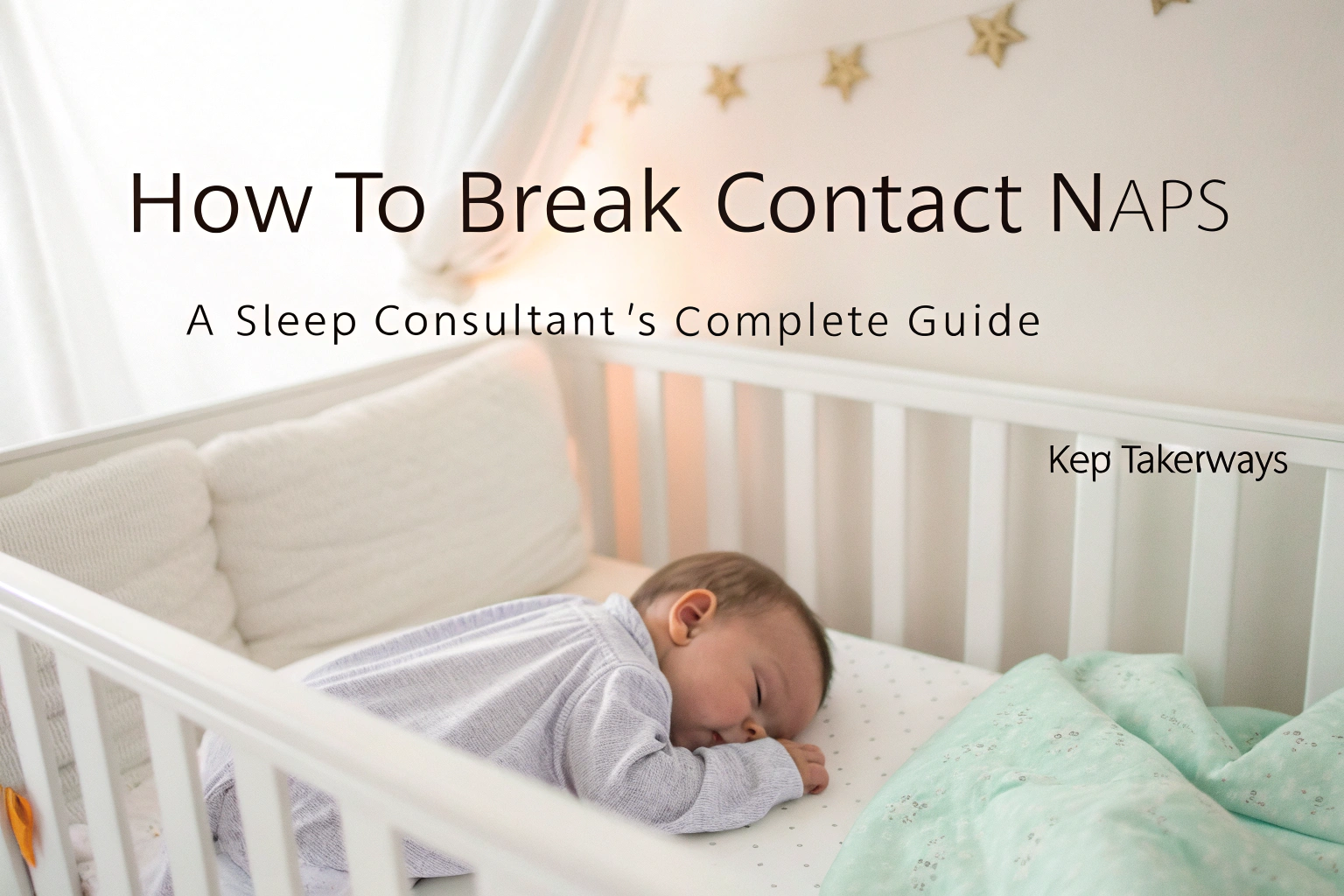Learning how to break contact naps involves gently transitioning your baby from sleeping only while being held to napping independently in a crib or bassinet. This process helps your baby develop self-soothing skills while allowing you to regain personal time and freedom. Many parents seek this change to create a more flexible and sustainable sleep routine, aiming to make the transition smooth and stress-free for their child and themselves.
Key Benefits at a Glance
- Benefit 1: Regain personal time and freedom to handle tasks, rest, or take a break while your baby sleeps safely nearby.
- Benefit 2: Promote your baby’s ability to self-soothe and fall asleep independently, a crucial skill for long-term healthy sleep habits.
- Benefit 3: Establish a more consistent and predictable nap routine, which helps ensure your baby gets the restorative daytime sleep they need.
- Benefit 4: Ensure a safer sleep environment by transitioning naps to a firm, flat surface in a crib or bassinet, away from pillows or soft furniture.
- Benefit 5: Improve sleep quality for everyone, as independent naps can lead to longer, more consolidated rest for the baby and less stress for the caregiver.
Purpose of this guide
This guide is for parents and caregivers who feel tied down by contact naps and are ready to help their baby learn to sleep independently. It solves the problem of nap dependency by offering gentle, actionable steps for a smooth transition. You will learn how to create a positive sleep environment, introduce the crib gradually, and manage setbacks without distress. The goal is to avoid common mistakes, like moving too quickly, and to empower you with strategies that foster a sustainable nap routine for long-term success.
I understand the overwhelming feelings many parents experience with contact naps—that beautiful yet exhausting dance of holding your sleeping baby while your own needs wait. As a certified sleep consultant who has guided over 800 families through this exact transition, I’ve witnessed the mixed emotions of wanting to preserve those precious snuggling moments while desperately needing your arms back. This comprehensive guide will provide you with gentle, evidence-based strategies to help your little one develop independent sleep skills while maintaining the deep connection you both cherish.
- Gentle transition methods that preserve parent-child bonding
- Age-appropriate strategies for different developmental stages
- Step-by-step guidance from a certified sleep consultant
- Real solutions for common challenges like short naps and transfer wake-ups
- Safety guidelines for contact napping during transition
Quick start guide breaking contact naps
If you’re reading this at 2 AM with a sleeping baby on your chest, you need actionable steps now. The transition from contact naps to independent sleep typically takes 1-2 weeks with consistent implementation, though every baby’s timeline varies. While this quick-start guide provides immediate direction, the detailed methods below contain crucial information for long-term success that has helped countless families in my practice achieve peaceful, independent naps.
- Assess your baby’s readiness using developmental markers
- Optimize sleep environment with proper temperature and lighting
- Establish consistent pre-nap routine lasting 10-15 minutes
- Choose appropriate transition method based on baby’s temperament
- Practice gradual implementation over 1-2 weeks
Understanding contact naps what they are and why babies love them
Contact naps occur when babies sleep while being held, carried, or in direct physical contact with a caregiver. This sleep pattern stems from evolutionary biology—newborns are born expecting the continuous warmth, movement, and sounds they experienced in the womb. During my consultations, I most commonly observe babies sleeping peacefully on parents’ chests, in arms while rocking, or nestled in carriers during walks. This behavior represents a normal developmental phase, not a problematic habit that needs immediate correction.
- Mimics the warmth and movement of the womb environment
- Provides constant parental heartbeat and breathing sounds
- Offers immediate comfort when baby stirs between sleep cycles
- Satisfies newborn’s need for close physical contact
- Helps regulate baby’s temperature and stress hormones
The fourth trimester concept explains why contact naps feel so natural—babies need gradual adjustment to life outside the womb. The gentle rise and fall of your breathing, your familiar scent, and the security of your embrace create an optimal sleep environment that closely resembles their previous nine-month home. Understanding this biological drive helps parents approach the transition with patience and compassion rather than frustration.
Benefits and drawbacks of contact naps
Contact napping offers genuine advantages for both babies and parents, particularly in the early months. Research consistently supports the benefits of skin-to-skin contact for infant development, attachment formation, and parental bonding. I’ve worked with families who describe contact naps as some of their most treasured early parenting memories—those quiet moments of connection while watching their baby sleep peacefully in their arms.
| Benefits | Drawbacks |
|---|---|
| Enhanced bonding and attachment | Physical strain on parent’s neck and back |
| Increased oxytocin production | Limited mobility for daily tasks |
| Better regulation of baby’s temperature | Difficulty getting adequate rest |
| Reduced crying and fussiness | Potential sleep dependency development |
| Easier feeding for breastfeeding mothers | Risk of accidental co-sleeping |
However, the challenges become apparent as weeks turn into months. Many parents in my practice describe feeling physically exhausted, unable to accomplish basic household tasks, or experiencing back and neck pain from prolonged holding positions. The key insight I share with families is that transitioning to independent naps doesn’t eliminate bonding opportunities—it simply shifts them to wakeful periods when both parent and baby can be more present and engaged.
Are contact naps safe
Safety remains the paramount concern with contact napping. While contact naps can be practiced safely when caregivers remain fully alert, the risks increase significantly if parents become drowsy or fall asleep. According to safe sleep guidelines, the American Academy of Pediatrics emphasizes that adult sleep surfaces and furniture like couches pose serious suffocation risks for infants.
- Never sleep while baby is contact napping on your chest
- Avoid soft surfaces like couches or recliners for contact naps
- Keep baby’s airway clear and face visible at all times
- Limit contact nap sessions to 2 hours maximum
- Have another adult present if you feel drowsy
In my practice, I advise parents to recognize their own fatigue levels honestly. If you find yourself nodding off during contact naps, it’s time to transition to safer sleep arrangements. I recommend setting phone alarms during contact nap sessions and having a partner take over if exhaustion becomes overwhelming. The goal is preserving both the benefits of closeness and the safety that independent sleep provides.
When do babies outgrow contact naps
There’s no universal timeline for outgrowing contact naps, as each baby develops at their own pace. In my experience working with hundreds of families, most babies begin showing readiness for independent sleep between 3-6 months, coinciding with neurological maturation and increased environmental awareness. However, I’ve successfully helped families transition babies as young as 8 weeks and others who maintained some contact naps well into toddlerhood.
“Sleep consultants say the soonest you could stop contact naps is 3-4 months, but there is no need to stop contact naps if they are working for you. As a baby’s sleep patterns mature and they start to nap less and sleep more soundly, they may start outgrow contact naps. The transition can happen naturally and at different stages for every child.”
— Pampers, March 2024
Source link
A crucial misconception I address with clients is the fear of “spoiling” babies with too much holding. Responsive caregiving during the fourth trimester actually builds security and trust, creating a foundation for future independence. The developmental shift typically occurs when babies become more interested in their surroundings, show longer periods of alertness, and begin developing self-soothing behaviors like thumb sucking or bringing hands to mouth.
Signs your baby is ready for independent naps
Recognizing readiness signs prevents premature transitions that can increase stress for both baby and parents. Through my consultations, I’ve identified key developmental markers that indicate a baby’s neurological and emotional readiness for independent sleep. Physical readiness often precedes emotional readiness, so observing multiple indicators provides the best guidance for timing your transition.
Learn what developmental milestones signal readiness for sleep independence—and other parenting transitions: When Does It Get Easier With a Baby.
- Shows interest in surroundings during wake periods
- Can self-soothe by sucking fingers or thumb
- Sleeps for longer stretches at night (4+ hours)
- Demonstrates consistent sleep-wake patterns
- Shows signs of outgrowing swaddle or Moro reflex fading
The most reliable indicator I observe is when babies begin showing curiosity about their environment during awake periods, turning their heads toward sounds and following objects with their eyes. This increased awareness suggests their nervous systems are maturing enough to handle the sensory input of independent sleep. Additionally, babies who demonstrate any self-soothing behaviors—even briefly bringing hands to mouth—often possess the foundational skills needed for independent settling.
Setting up the perfect sleep environment
Environmental optimization forms the foundation of successful nap transitions. A properly configured sleep space can dramatically reduce the adjustment period, as it recreates some of the sensory conditions babies experienced during contact naps. In my practice, I’ve seen simple environmental modifications turn struggling nappers into peaceful independent sleepers within days.
“Before you set your baby down in a crib or bassinet, make sure that they have a healthy sleep environment. Some things to think about are the temperature in the room, the lighting, noise level and set-up of the room. Ideally, your baby’s sleep space is between 68 degrees and 72 degrees Fahrenheit, is as dark as possible, (blackout curtains can help) is quiet aside from white noise and is free of distractions and clutter.”
— Motherly, April 2024
Source link
Temperature control proves particularly crucial, as babies easily become too warm or cold when transitioning from the regulated environment of contact naps. I recommend using a room thermometer and dressing babies in appropriate sleep clothing—typically one layer more than what an adult would find comfortable. White noise machines should produce consistent, non-rhythmic sounds at 50-65 decibels, roughly equivalent to a gentle shower or rainfall.
- Set room temperature between 68-70°F (20-21°C)
- Install blackout curtains or shades for darkness
- Use white noise machine at consistent volume
- Ensure crib meets current safety standards
- Remove all loose bedding and toys from sleep space
Lighting management extends beyond simple darkness—I advise families to use dim, warm lighting during pre-nap routines and complete darkness during sleep periods. The contrast helps signal sleep time while maintaining the calm atmosphere that facilitates easy transitions. One client family found that simply adding blackout curtains increased their baby’s nap duration from 30 minutes to over an hour within three days.
The science of baby sleep cycles
Understanding infant sleep architecture provides crucial insight for timing nap transitions effectively. Baby sleep cycles last approximately 45-60 minutes, significantly shorter than adult cycles, with more time spent in active REM sleep. This biological reality explains why many babies wake after short periods when transitioning to independent sleep—they’re naturally entering lighter sleep phases where environmental factors have greater impact.
Newborns spend about 50% of sleep time in REM, gradually decreasing to 25% by age one. During REM sleep, babies experience more movement, irregular breathing, and increased sensitivity to disturbances. This knowledge helps parents understand that brief awakenings between sleep cycles are normal, not indicators of failed independent sleep attempts.
| Age Range | Wake Windows | Total Daily Sleep |
|---|---|---|
| 0-3 months | 45-90 minutes | 14-17 hours |
| 4-6 months | 1.5-2.5 hours | 12-15 hours |
| 7-9 months | 2-3 hours | 12-14 hours |
| 10-12 months | 3-4 hours | 11-14 hours |
| 13-18 months | 4-6 hours | 11-13 hours |
Wake windows—the optimal time babies can stay awake between sleep periods—provide essential timing guidance for nap attempts. Babies who are under-tired often resist sleep, while over-tired babies become dysregulated and have difficulty settling. I teach families to observe their baby’s natural rhythms and adjust timing based on individual patterns rather than rigid schedules.
5 effective methods to break contact naps
Every baby responds differently to sleep transitions, which is why I’ve developed multiple approaches based on temperament, age, and family preferences. Through my work with hundreds of families, I’ve refined these five methods to address various scenarios and comfort levels. Some babies respond quickly to gentle approaches, while others require more structured techniques. The key lies in selecting the method that aligns with your baby’s personality and your family’s parenting philosophy.
For a gentler, crib-focused approach to ending contact naps, see this detailed transition guide: Transition from Contact Napping to Crib with Ease.
You can also review sleep training basics for gradual approaches that complement these specific techniques.
Method 1 the gradual transfer technique
The gradual transfer technique works exceptionally well for sensitive babies who startle easily or have strong preferences for contact. This method honors babies’ need for security while slowly introducing independent sleep. I developed this approach after observing that abrupt transitions often resulted in increased crying and longer adjustment periods, while gradual changes allowed babies to maintain feelings of safety throughout the process.
- Hold baby until deeply asleep (15-20 minutes)
- Move slowly toward crib, maintaining contact
- Lower baby feet-first into crib while supporting head
- Keep hands on baby’s chest for 2-3 minutes
- Gradually reduce pressure and slowly lift hands away
Success with this method requires patience and consistency. I advise parents to practice during the first nap of the day when babies are typically most rested and receptive. One client, Sarah, struggled with this technique initially but found that warming the crib sheet with a heating pad before transfer significantly improved her success rate. After one week of consistent practice, her 4-month-old son was sleeping independently for 90-minute naps.
Method 2 the chair method
The chair method provides reassurance through parental presence while encouraging independent settling. This approach works particularly well for babies who need visual confirmation of parental availability but can learn to self-soothe when feeling secure. I’ve found this method most successful with babies aged 4-8 months who have developed object permanence and can understand that parents are nearby even when not being held.
- Place chair directly beside crib for first 3 days
- Move chair 2 feet away from crib for next 3 days
- Position chair halfway to door for following 3 days
- Move chair to doorway for next 3 days
- Gradually reduce time spent in room each day
The key to chair method success lies in remaining calm and boring—avoid eye contact, talking, or providing entertainment that might stimulate rather than soothe. I instruct parents to bring a book or quiet activity to maintain their own calm presence. Babies typically adjust to each chair position within 2-3 days, though some may require longer at certain stages depending on their attachment needs and temperament.
Method 3 the pick up put down technique
This responsive approach balances comfort with independence training, teaching babies that parents will provide support while encouraging self-settling skills. The technique requires significant patience and consistency but often results in strong independent sleep skills because babies learn to trust that comfort is available when truly needed. I particularly recommend this method for anxious babies or those with sensitive temperaments.
- DO pick up only when baby is actively crying
- DON’T pick up for fussing or light protests
- DO put down as soon as baby calms (not asleep)
- DON’T rock or bounce while holding baby
- DO maintain consistent, calm demeanor throughout
The timing of interventions proves crucial—picking up too quickly prevents learning, while waiting too long can escalate distress unnecessarily. I teach parents to distinguish between different types of crying and respond appropriately to each. Most families see significant progress within 5-7 days, though the initial implementation can be emotionally challenging for parents who are accustomed to immediate soothing.
Method 4 the drowsy but awake approach
This fundamental sleep skill involves putting babies down before they’re fully asleep, allowing them to experience the transition into sleep independently. The technique builds crucial self-settling abilities that serve babies throughout childhood. However, achieving the perfect state of drowsiness requires practice and careful observation of individual sleep cues.
- Eyes are heavy-lidded but still occasionally opening
- Body feels relaxed and less active than when alert
- Breathing has slowed to a deeper, more regular pattern
- Baby may yawn or show other tired cues
- Responds less actively to environmental stimuli
The challenge lies in finding the narrow window between alert and asleep. Too awake, and babies may become stimulated by the crib environment; too sleepy, and they may startle when placed down. I teach parents to observe their baby’s unique drowsiness cues and adjust timing accordingly. Some babies show drowsiness through droopy eyelids, while others become very still or lose interest in surroundings.
Method 5 the crib hour rule
This structured approach establishes consistent expectations around nap time, helping babies learn that cribs are for sleeping regardless of initial resistance. The method works by creating predictable patterns that support circadian rhythm development while allowing babies to practice self-settling skills without time pressure.
- Put baby in crib at designated nap time
- Leave baby in crib for full hour regardless of sleep
- Provide brief comfort checks every 10-15 minutes if needed
- Remove baby after one hour even if no sleep occurred
- Maintain consistent timing for all nap periods
Many parents initially worry about babies spending time awake in cribs, but I’ve observed that this quiet time often contributes to eventual sleep success. Babies learn that cribs are calm, safe spaces where sleep happens naturally. The method typically shows results within 3-5 days, with babies gradually settling more quickly and sleeping for longer periods as they adjust to the routine.
Establishing a consistent nap routine
Predictable pre-nap rituals create powerful sleep associations that ease the transition from contact naps to independent sleep. Routines signal to babies that sleep time is approaching, helping their nervous systems begin the physiological process of winding down. I’ve observed that families with consistent routines typically experience smoother transitions and maintain independent sleep skills more successfully long-term.
Consistent routines reduce parental stress and mental load—key factors in preventing mom burnout: How to Explain Mom Burnout to Your Husband.
The most effective routines incorporate sensory elements that were present during contact naps—gentle movement, soft sounds, and calming touch—while gradually introducing crib-based activities. This bridges the gap between familiar contact experiences and new independent sleep expectations.
| Age Range | Routine Duration | Key Activities |
|---|---|---|
| 0-3 months | 5-10 minutes | Diaper change, swaddle, gentle rocking |
| 4-6 months | 10-15 minutes | Story, dim lights, sleep sack, crib placement |
| 7-12 months | 15-20 minutes | Quiet play, book, sleep sack, brief cuddle |
| 12+ months | 15-25 minutes | Potty/diaper, story, songs, comfort item |
I emphasize that routines should be calming rather than stimulating, avoiding activities that might increase alertness or excitement. The goal is creating positive associations with the sleep space while maintaining elements of comfort and security. One family I worked with found that singing the same lullaby during both contact naps and crib routines helped their baby feel secure during the transition.
Common challenges and solutions
Every family encounters obstacles during the contact nap transition, and recognizing these as normal parts of the process helps maintain confidence and consistency. Through my extensive practice, I’ve identified the most frequent challenges and developed targeted solutions that address both the immediate problem and underlying causes.
| Challenge | Primary Cause | Recommended Solution |
|---|---|---|
| Short 30-minute naps | Incomplete sleep cycles | Practice crib hour and gradual extension |
| Immediate wake on transfer | Moro reflex or temperature change | Use sleep sack and slower transfer technique |
| Increased night wakings | Overtiredness from poor naps | Maintain consistent bedtime routine |
| Resistance to crib | Strong sleep associations | Implement gradual transition method |
Understanding the root cause of each challenge allows for more targeted interventions rather than generic solutions. For example, babies who consistently wake after 30 minutes are likely transitioning between sleep cycles and need support learning to connect cycles independently. This requires different strategies than babies who wake immediately upon transfer, who may be responding to environmental changes or startle reflexes.
Dealing with short naps during transition
Short naps represent one of the most common frustrations during contact nap transitions. These brief sleep periods often result from babies waking at natural cycle transitions without the comfort and movement that previously helped them settle back to sleep. Understanding this biological reality helps parents respond appropriately rather than abandoning independent sleep attempts prematurely.
- Wait 5-10 minutes before intervening when baby wakes
- Try gentle patting or shushing without picking up
- Use white noise to mask environmental disruptions
- Ensure optimal room temperature and darkness
- Gradually extend intervention time over several days
The key insight I share with families is that sleep cycle connection is a learned skill that develops with practice. Many babies will resettle independently if given opportunity, but parents often intervene too quickly out of concern or frustration. I recommend tracking nap patterns for one week to identify trends and determine whether short naps are improving gradually or remaining consistently brief.
When your baby wakes immediately after transfer
Transfer wake-ups often result from physiological responses to environmental changes—temperature differences, loss of movement, or activation of the Moro reflex. These responses are normal protective mechanisms, not indicators of failed technique or baby resistance to independent sleep.
- Warm the crib sheet with a heating pad before transfer
- Use a sleep sack to minimize temperature shock
- Support baby’s head and neck throughout entire transfer
- Move in slow, fluid motions rather than quick movements
- Keep one hand on baby’s chest for several minutes after placement
Temperature regulation proves particularly important, as babies transitioning from warm parental contact to cooler crib environments often wake from the thermal change. I advise families to dress babies appropriately for the room temperature and consider using sleep sacks that maintain consistent warmth. Additionally, supporting babies through the entire transfer process—rather than rushing to place them down—significantly reduces startle responses.
Handling nap resistance and crying
Some level of protest is normal and expected during contact nap transitions, as babies communicate their preference for familiar sleep conditions. However, distinguishing between different types of crying helps parents respond appropriately—providing comfort when needed while allowing natural adjustment processes to occur.
- Mantra crying: Rhythmic, repetitive – allow baby to self-settle
- Escalating crying: Getting louder/more intense – provide comfort check
- Hysterical crying: Inconsolable distress – pick up and soothe
- On-and-off crying: Intermittent protests – wait and observe pattern
- Sleepy crying: Decreasing intensity – baby is learning to settle
I teach parents that crying during sleep transitions often represents communication rather than distress—babies are expressing their preferences and learning new skills simultaneously. The goal is supporting this learning process while maintaining emotional connection and trust. Most families find that crying decreases significantly within 3-5 days as babies adjust to new sleep expectations.
Success stories how my clients broke the contact nap habit
Real family experiences demonstrate that successful contact nap transitions are achievable across various ages, temperaments, and starting situations. These stories illustrate both the challenges and rewards of independent sleep development, providing encouragement and practical insights for families beginning their own transitions.
Emma, a 5-month-old who had never slept independently, transitioned using the gradual transfer method combined with environmental optimization. Her parents initially struggled with transfer wake-ups but found success by warming the crib sheet and using a weighted sleep sack. Within 10 days, Emma was napping independently for 90-120 minutes twice daily, and her parents reported feeling significantly less physical strain and more rested.
Marcus, a sensitive 3-month-old, required the chair method approach due to his need for visual parental presence. His parents spent two weeks gradually moving their chair further from his crib, providing calm reassurance while encouraging independent settling. The process required patience, but Marcus eventually learned to sleep peacefully knowing his parents were nearby. By month four, he was sleeping independently without needing parental presence.
Contact nap compromises partial solutions for gradual transition
Not every family needs or wants to eliminate contact naps completely, and partial solutions can provide relief while maintaining some of the closeness that both parents and babies enjoy. These compromise approaches work particularly well for families who want to preserve bonding time while gaining some freedom during daily routines.
- Carrier naps for one nap, crib for others during transition
- Contact nap for first half, transfer for second half
- Weekend contact naps, weekday independent naps
- Morning contact nap, afternoon crib naps
- Gradual reduction: 4 contact naps to 3 to 2 to 1 to none
I often recommend the “one contact nap per day” approach for families who want to maintain bonding while developing independent sleep skills. This allows babies to practice self-settling regularly while preserving special connection time. The key is maintaining consistency—if you designate the morning nap as a contact nap, stick to that pattern to avoid confusing sleep expectations.
When to seek professional help
While many families successfully transition from contact naps independently, certain situations benefit from professional guidance and support. As a sleep consultant, I recognize when families need additional resources beyond general advice, and I’m transparent about scenarios where professional intervention can accelerate progress and reduce stress.
- No progress after 2-3 weeks of consistent effort
- Baby’s sleep is getting worse instead of better
- Family stress levels are becoming unmanageable
- Multiple sleep issues beyond just contact naps
- Conflicting advice from various sources causing confusion
Professional sleep consultants provide personalized assessment, customized strategies, and ongoing support throughout the transition process. We can identify specific factors affecting your baby’s sleep patterns and adjust approaches based on individual responses. Additionally, having expert guidance often provides parents with confidence and reassurance during challenging moments, leading to more consistent implementation and faster results.
Conclusion embracing independent sleep while maintaining connection
Breaking contact naps doesn’t mean breaking the precious bond you’ve built with your baby. Instead, it represents an evolution in your relationship—moving from physical dependence to emotional security that supports healthy development and family wellbeing. Through my work with hundreds of families, I’ve witnessed how independent sleep skills actually enhance parent-child connections by ensuring everyone gets the rest needed for positive interactions.
- Maintain skin-to-skin contact during awake periods
- Create special bonding rituals outside of sleep times
- Use feeding times for close connection and eye contact
- Incorporate gentle massage into daily routine
- Celebrate independent sleep as a developmental milestone
Remember that healthy sleep habits benefit the entire family. When babies sleep well independently, parents have opportunities for rest, self-care, and maintaining relationships that ultimately support better parenting. Your baby’s ability to sleep peacefully in their own space represents growing confidence and security—qualities that serve them throughout life. If you find yourself struggling with this transition, remember that seeking support is a sign of good parenting, not failure. Every family’s journey is unique, and with patience, consistency, and the right approach, your baby will develop the independent sleep skills that benefit everyone.
Frequently Asked Questions
To get your baby to nap without contact, start by establishing a consistent nap routine that includes dim lighting and white noise to create a soothing environment. Gradually place your baby in the crib drowsy but awake, offering comfort from afar if needed, and be patient as this transition can take time. If your baby is teething, provide extra soothing techniques like a chilled teether before naps to ease discomfort and promote independent sleep.
Stopping contact naps involves slowly reducing the time you hold your baby by using techniques like patting or shushing while they’re in the crib. Introduce a comfort item, such as a soft blanket, to help them feel secure without your direct contact. During periods of teething, which can disrupt sleep, maintain consistency to avoid setbacks in the process.
You can start transitioning away from contact naps around 4-6 months when babies often develop more predictable sleep patterns and self-soothing abilities. Observe your baby’s cues and readiness, as some may need more time, especially during teething phases that affect comfort. For dads involved in babywearing, knowing how to measure waist for men ensures carriers fit well during any remaining contact naps.
Breaking the contact nap habit typically takes 1-4 weeks, depending on your baby’s age, temperament, and consistency in your approach. Start with short practice sessions and gradually increase independence, monitoring for regressions during events like teething. Patience and a supportive routine are key to success without causing undue stress.
If your baby refuses to nap without being held, try swaddling or using a pacifier to mimic the security of contact while placing them in the crib. Implement sleep training methods gently, and consider if teething pain is contributing to the resistance, addressing it with appropriate remedies. Over time, most babies adapt with consistent encouragement.
A gradual transition from contact naps is often recommended to minimize stress, starting by holding your baby until drowsy and then transferring to the crib. This method allows your baby to adjust slowly, especially helpful during teething when they may need extra comfort. For men using carriers, learning how to measure your waist properly can enhance comfort in transitional babywearing sessions.




